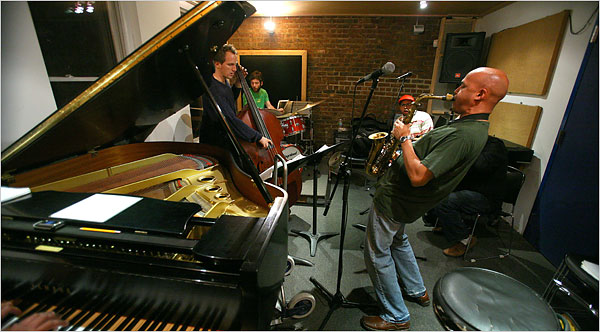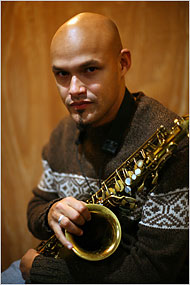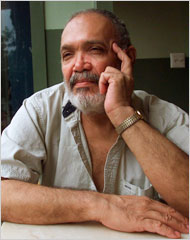G. Paul Burnett/The New York Times

Miguel Zenón with his band, including the bassist Hans Glawischnig, the drummer Henry Cole and Obanilu Allende, in hat, who plays plena rhythms.
By BEN RATLIFF
Published: December 3, 2008
When the jazz saxophonist and composer Miguel Zenón visits his native Puerto Rico to see his mother and other relatives every year around Christmastime, he rarely hears any jazz. Instead he’s surrounded by plena, a century-old Afro-Caribbean musical tradition, a kind of movable street-corner folksong.

The composer and saxophonist Miguel Zenón.
Plena is made with three different-size panderos (like tambourines without the cymbals) and voices singing about island myths and scandals, cultural identity, political reality, love and plena itself.
“It’s really common,” he said in an interview last week in Washington Heights, where Mr. Zenón, 31, now lives with his wife, Elga Castro, a Ph.D. candidate in political science at the New School. “And it’s so simple that you find it at a basketball game, at church — anywhere.”
Panderos are easily portable, as opposed to the barrel-shaped drums used in bomba, another island music. And the four-beat plena rhythm has also been part of the holiday-season ritual of parranda, which is akin to Christmas caroling: surprise late-night musical visits to the neighbors.
Part of the jazz tradition is using whatever’s in front of you, and Mr. Zenón, a New Yorker since 1999, has done this before. His album “Jíbaro” (Marsalis Music), from 2005, dealt with the song form of Puerto Rican back-country troubadours, and it had a preoccupation with numbers, particularly in the décima, a 10-line stanza with specific rhyme schemes.
“Jíbaro” threads Puerto Rican folklore through small-group jazz played at a high level, led by Mr. Zenón’s limpid and graceful alto saxophone sound. The album helped establish Mr. Zenón as one of the important contemporary revisers of Latin jazz and spread his reputation for delivering excellent music from a complicated premise, a reputation that reached the secret committees of the MacArthur Foundation, which awarded him one of its $500,000 “genius” grants in September.
This year Mr. Zenón also received a Guggenheim research grant and took a long fact-finding trip back to Puerto Rico. To ask for introductions to the living plena masters, he sought out Hector (Tito) Matos, a plena practitioner who has played with the long-running New York band Los Pleneros de la 21, as well as his own group, Viento de Agua.
Mr. Matos pointed him toward historians and older musicians like Modesto Cepeda and Ismael (Cocolai) Rivera so that Mr. Zenón could understand the music’s origins and functions. He learned about the subtle differences, for instance, between the San Juan-style use of the open hand on the pandero and the slower-tempo “punta de clavo” fingertip style of Mayagüez.
An insight from Ramón López, an ethnomusicologist who has written about plena, helped Mr. Zenón with his work. “He said something to me about how the moment you put plena onstage, it’s not the real thing anymore,” Mr. Zenón said. “So he told me not to worry about it, because it’s already different from what it’s supposed to be.”
Mr. Matos said: “That he decided to focus on plena for a whole recording and a whole research project, that surprised me right away. It’s very important what Miguel is doing, to open the music we play to more ears around the world.”
Mr. Zenón used his research for his composition “Esta Plena,” a work in 10 parts: half instrumental, half with singing. (He wrote his own lyrics too: about the nature of plena, about an all-night New Year’s party at Mr. Matos’s house, about political corruption and the disappearance of cultural tradition.) It will be performed for the first time this week, Thursday through Sunday, at the Jazz Gallery in the South Village. The performances feature his working quartet — Mr. Zenón, the pianist Luis Perdomo, the bassist Hans Glawischnig and the drummer Henry Cole — as well as three extra musicians playing plena rhythms and singing: Mr. Matos, Juan Gutiérrez and Obanilu Allende.
Again in “Esta Plena” Mr. Zenón used numbers as an organizing principle. “There are three panderos in plena,” he said. “So I dealt with the number three. In terms of form I wrote a lot of phrases in three or six. Harmonically I started thinking in terms of major-third intervals and augmented triads, and from there I built melodies and chord progressions.”
That the basic plena rhythm is always in four — with the biggest drum accenting the one and three, the middle one accenting the three and four, and the smallest providing improvised accents — didn’t deter Mr. Zenón. Through “Esta Plena” he has kept the four-beat percussive plena rhythm steady, while writing melodic cycles for the rest of the band in three or nine.
If you think that sounds complex, you’re right. (Mr. Zenón graduated from Berklee College of Music in 1998 and had no formal math training beyond high school. Still, he has a math-and-science way of thinking.) Yet his compositions are always clear and organized, and when they’re making references to folklore, they keep the feeling of dance in them.
The number three, incidentally, has no other significance than the three panderos. Mr. Zenón laughed at the notion that it could signify the trinity. “When I write anything, I need something concrete to help me, something outside of music,” he explained. “On another project it might be letters.”
After the shows at the Jazz Gallery Mr. Zenón will record “Esta Plena” for his next album. And — given the financial freedom of the MacArthur award — then what?
He has an idea. Recently, he said, he was watching the documentary “Heima,” about how the Icelandic rock band Sigur Ros thanked the fans in its home country by playing an unusual series of free concerts: in factories, small-town community centers and even in fields and caves. Mr. Zenón said he got the urge to do something similar in Puerto Rico, particularly in small towns and mountainside areas where jazz is almost never heard.
It could make a difference, he said, to play jazz of the sturdiest sort; not his own, but music by Charlie Parker or John Coltrane or Miles Davis. He might also talk to audiences about improvising, play them records, offer clinics.
“When I grew up there,” he said, “there wasn’t really any live jazz. It was usually background music, and it was always the same eight or nine guys in San Juan. So I saw this movie, and I started thinking: man, if I could do that, just play the music, without having to worry about the business part — tickets, publicity, who’s going to pay the guys, are enough people going to show up — it would be incredible.”
Miguel Zenón performs Thursday through Sunday, 9 and 10:30 p.m., at the Jazz Gallery, 290 Hudson Street, South Village, (212) 242-1063, jazzgallery.org.



